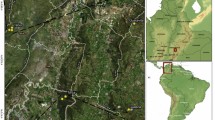The species richness and conservation status of primates in the Reserva Comunal Tamshiyacu-Tahuayo, northeastern Peru, located between the Yavari and Amazon rivers is reported. Two sites within a continuous forest were studied in the 322 500 ha reserve. Primate densities were estimated from censuses of 290 km of line transects using Fourier series expansion. Fourteen species of anthropoid primates have been confirmed to occur sympatrically in the Reserva Comunal Tamshiyacu-Tahuayo which is the greatest species richness of primates reported to date within a Peruvian conservation unit. Hunting by local inhabitants has decreased the densities and biomasses of Cebids in the reserve, but not Callitrichids. A management plan for hunting in the Reserva Comunal Tamshiyacu-Tahuayo has been developed to better conserve primates and other mammalian species.
Similar content being viewed by others
References
Aquino, R., Puertas, P. and Encarnación, F. (1990) Supplemental notes on population parameters of northeastern Peruvian night monkeys, genus Aotus (Cebidae). Am. J. Primatol. 21, 215–21.
Ayres, J.M. (1986) Uakaris and Amazonian flooded forest. Ph.D. Thesis, University of Cambridge. (Unpublished).
Ayres, J.M. and Clutton-Brock, T.H. (1992) River boundaries and species range size in Amazonian primates. Am. Nat. 140, 531–7.
Bodmer, R.E., Bendayán, N.Y., Moya, I., Moya, L. and Fang, T.G. (1990a) Manejo de ungulados en la Amazonía Peruana: análisis de la caza de subsistencia y la comercialización local, nacional e internacional. Bol. Lima 70, 49–56.
Bodmer, R.E., Fang, T.G., Moya I. L. and Gill, R. (1993) Managing wildlife to conserve Amazonian forests: population biology and economic considerations of game hunting. Biol. Conserv. (In press).
Bodmer, R.E., Penn, J., Fang, T.G. and Moya, I., Moya, L. (1990b) Management programmes and protected areas — the case of the Reserva Comunal Tamshiyacu-Tahuayo, Peru. Parks 1, 21–5.
Brockelman, W.Y. and Ali, R. (1987) Methods of surveying and sampling forest primate populations. In Primate Conservation in Tropical Rain Forests (C.W., Marsh and R.A., Mittermeier, eds) pp. 23–62. New York: Alan R. Liss.
Burnham, K.P., Anderson, D.R. and Laake, J.L. (1980) Estimation of density from line transect sampling of biological populations. Wildlife Monogr. 72.
Eisenberg, J.F. (1989) Mammals of the Neotropics: The Northern Neotropics. Chicago: University of Chicago Press.
Gentry, A.H. (1988) Tree species richness of upper Amazonian forests. Proc. Nat. Acad. Sci. 85, 156–9.
Haffer, J. (1969) Speciation in Amazonian forest birds. Science 165, 131–7.
Hart, J.A., Hart, T.B. and Thomas, S. (1986) The Ituri forest of Zaire: primate diversity and prospects for conservation. Primate Conserv. 7, 42–4.
Hershkovitz, P. (1977) Living New World Monkeys (Platyrrhini) with an Introduction to Primates. Chicago: University of Chicago Press.
Hershkovitz, P. (1983) Two new species of night monkeys, genus Aotus (Cebidae, Platyrrhini): a preliminary report on Aotus taxonomy. Am. J. Primat. 4, 209–43.
Hershkovitz, P. (1984) Taxonomy of squirrel monkeys genus Saimiri (Cebidae, Platyrrhini): a preliminary report with description of hitherto unnamed form. Am. J. Primatol. 7, 155–210.
Hershkovitz, P. (1987a) Uacaries, New World monkeys of the genus Cacajao (Cebidae, Platyrrhini): a preliminary taxonomic review with description of a new subspecies. Am. J. Primatol. 12, 1–53.
Hershkovitz, P. (1987b) The taxonomy of South American sakis, genus Pithecia (Cebidae, Platyrrhini): a preliminary report and critical review with description of a new species and a new subspecies. Am. J. Primatol. 12, 387–468.
Hershkovitz, P. (1989) Origin, speciation, and distribution of South American titi monkeys, genus Callicebus (Family Cebidae, Platyrrhini). Proc. Acad. Nat. Sci. Philadelphia 140, 240–72.
Janson, C.H. and Emmons, L.H. (1990) Ecological structure of the nonflying mammal community at Cocha Cashu Biological Station, Manu National Park, Peru. In Four Neotropical Rainforests (A.H., Gentry, ed.) pp. 314–38. New Haven: Yale University Press.
MacLean, P.D. (1964) Mirror display in the squirrel monkey, Saimiri sciureus. Sci. 146, 950–2.
Mittermeier, R.A. (1988) Primate diversity and the tropical forest: case studies from Brazil and Madagascar and the importance of megadiversity countries. In Biodiversity (E.O., Wilson, ed.) pp. 145–54. Washington D.C.: National Academy Press.
Nelson, B.W., Ferreira, C.A.C., da, Silva, M.F. and Kawasaki, M.L. (1990) Endemism centres, refugia and botanical collection density in Brazilian Amazonia. Nature 345, 714–6.
Prance, G.T. (1985) The changing forest. In Key Environments: Amazonia (G.T., Prance and T.E., Lovejoy, eds) pp. 146–65. Oxford: Pergamon Press.
Rylands, A.B. and Bernardes, A.T. (1989) Two priority regions for primate conservation in the Brazilian Amazon. Primate Conserv. 10, 56–62.
Solbrig, O.T. (1991) From Genes to Ecosystems: A Research Agenda for Biodiversity. Cambridge Massachussets: IUBS-SCOPE-UNESCO.
Terborgh, J. (1983) Five New World Primates: A Study in Comparative Ecology. Princeton: Princeton University Press.
Western, D. and Pearl, M.C. (1989) Conservation for the Twenty-First Century. Oxford: Oxford University Press.
Author information
Authors and Affiliations
Rights and permissions
About this article
Cite this article
Puertas, P., Bodmer, R.E. Conservation of a high diversity primate assemblage. Biodivers Conserv 2, 586–593 (1993). https://doi.org/10.1007/BF00051959
Received:
Revised:
Accepted:
Issue Date:
DOI: https://doi.org/10.1007/BF00051959




